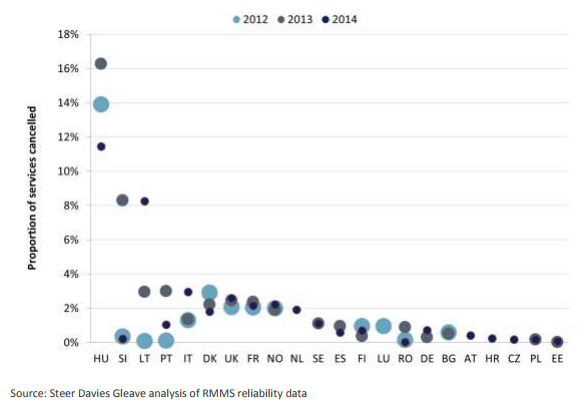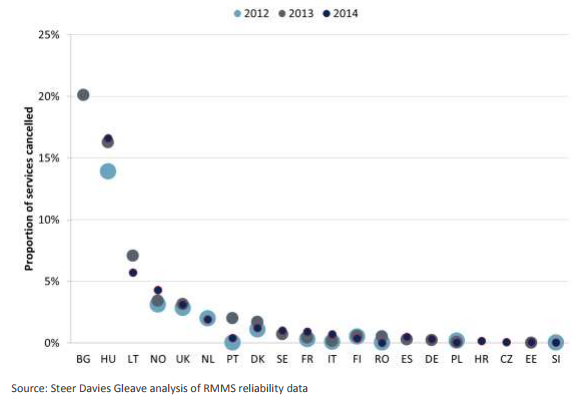4.1.1 to 4.1.3
Course subject(s)
4. Complexity of Disruptions
4.1.1 Complexity of Disruptions

The appearance of any undesired event is perceived as a disruption in the railway system. Extreme weather circumstances, failing technology (such as a broken switch) or human interference (e.g. someone walking on the track or a train driver who overslept) can all be reasons for a delayed train. There is a wide range of causes, which all have different effects on the system.
During this week, we will have a look at the most common causes and some of the more rare ones, and we will analyse how to deal with them. To prevent or reduce the number of disruptions, preventive maintenance strategies are planned by the railway operator and other parties involved. Nonetheless, even with preventive measures, some disruptions will occur due to external factors. Once a disruption has occurred, it must be resolved. The resolution of the issue should come after evaluating its cause and effect, the significance to the overall operation of the system, or whether it poses a risk in any way.
4.1.2 Breaking Down the Complexity
![]()
Most commuters have experienced a late train at least once. However, what you might not realise is that this late train (or any other event for that matter), can have many different causes. For example, there might be a technical issue, but also weather or human factors can cause that exact same delay.
For passengers, the cause is seldom visible. The effect of unhappy customers, however, is clearly visible when you are on the platform. And there will probably be further knock-on effects. Your late train might, for example, hinder another train at the next station. Even a single delay might have effects for a long time before everything is resolved.
Resolving the problems and the consequences is often a complex puzzle. To prepare for this, often many scenario’s are made beforehand which can be used as a guideline. Furthermore, computers can help finding the optimum in rescheduling to make sure the effects are as little as possible. Although, of course, the resolution is important, it is also good to look at what can be learned from a disruption to prevent it next time. For example, by increasing the robustness of the system, the amount of future disruptions and their effects can be reduced. Also maintenance can help to prevent future problems. In week 5 of this MOOC we will look deeper into maintenance.
The five layers of a disruption (as seen above) will be our guideline for the content of this week:
Events – Causes – Effects – Resolving – Prevention
Even though people often think they see the same disruptions, many disruptions are unique, differing from each other in one or more of these layers.
4.1.3 Different Events
We first will look at some very recognisable examples of disruptions. Later this week, we will discuss many more of them and also see that sometimes different events might have similar causes and solutions.
A delayed train is one of the many reasons why a disturbance can occur. The train might arrive later than the scheduled time of arrival, and/or the journey takes longer than expected.
Certain routes have a higher degree of sensitivity for delays. This is influenced by bottlenecks on the track, but also by the capacity of a railway line (the number of tracks available) and how often the track is being used.
If a train on a certain route is delayed, it can cause a chain reaction of delays for the trains that follow, because they have to slow down or wait on the delayed train.
Cancelling Trains
When a train is cancelled, it will be taken off the timetable and will not drive at all.
Depending on the frequency of the trains on a certain route, operators my decide it is optimal to remove a train from the schedule in order to prevent the following trains from being delayed.
Disturbances (on other routes) and technical problems are frequently the reason behind cancelled trains. If there are no tracks available, for example, due to a broken switch of maintenance, then trains can be cancelled. As a result, instead of the normal number of trains per hour, they will run with a lower frequency.
The cancellation of trains has a major impact on logistics planning, because trains are not in the place where they are expected. This effect is often still noticeable the next day.
Below you can see two charts showing the percentage of trains cancelled in different Member States of the European Union, where you can compare the reliability of these railway systems.


Left: Reliability of regional and local passenger services by EU member state
Right: Reliability of long-distance passenger services by EU member state
Another reason why a disturbance can occur is when a train does not comply with the normal standards. This can be technical, but also be a shortage of staff for example.
If a train does not suffice it has particularly influence on the user experience. This includes, for example, dirty trains, defective doors or having to wait for staff. Due to previous problems, there may also be difficulties with the composition of trains, which means there are less multiple-units than planned, decreasing the number of passengers the train is able to transport.
Occasionally, a train follows a different route than usual due to previous disturbances. This can be a solution for a delay, by skipping stations, or to process large crowds at events.
From a logistics point of view, this is an efficient way to solve delays, but it causes major inconvenience to passengers when their stations are skipped.

Railway Engineering: An Integral Approach by TU Delft OpenCourseWare is licensed under a Creative Commons Attribution-NonCommercial-ShareAlike 4.0 International License.
Based on a work at https://ocw.tudelft.nl/courses/railway-engineering-integral-approach/.




